Critical Factors Affecting Water and Nitrogen Losses from Sloping Farmland during the Snowmelt Process
Abstract
1. Introduction
2. Materials and Methods
2.1. Experimental Site Description
2.2. Sloping Farmland Preparation
2.3. Experimental Methods
2.4. Statistical Analyses
3. Results
3.1. Runoff during the Snowmelt Process
3.2. Nitrogen Losses during the Snowmelt Process
4. Discussion
4.1. Critical Factors Affecting Snowmelt Water Loss from Sloping Farmland
4.2. Critical Factors Affecting Nitrogen Losses from Sloping Farmland during Snowmelt
5. Conclusions
Author Contributions
Funding
Data Availability Statement
Conflicts of Interest
Appendix A
| Parameter | Treatments | NH4+-N | Flow Weighted Mean NH4+-N Concentration (mg/L) | ||||||||
|---|---|---|---|---|---|---|---|---|---|---|---|
| Yield (mg) | R (%) | ||||||||||
| Mar. 19 | Mar. 20 | Mar. 21 | Mar. 22 | Total | Mar. 19 | Mar. 20 | Mar. 21 | Mar. 22 | |||
| Snowmelt | SS_Snowmelt | 54.8 ± 11.8 | 100 | 0 | 0 | 0 | 1.9 ± 0.4 | 1.9 ± 0.4 | - | - | - |
| GS_Snowmelt | 50.0 ± 13.0 | 62 | 38 | 0 | 0 | 1.7 ± 0.2 | 2.3 ± 0.2 | 1.1 ± 0.2 | - | - | |
| Surface runoff | SS_HS_HSW | 24.9 ± 1.9 | 41 | 51 | 8 | 0 | 0.8 ± 0.0 | 0.8 ± 0.0 | 0.7 ± 0.0 | 1.1 ± 0.1 | - |
| SS_LS_HSW | 9.7 ± 3.7 | 82 | 18 | 0 | 0 | 1.0 ± 0.1 | 0.9 ± 0.0 | 1.9 ± 0.2 | - | - | |
| SS_LS_LSW | 9.3 ± 2.0 | 93 | 7 | 0 | 0 | 0.9 ± 0.1 | 0.9 ± 0.1 | 2.4 ± 0.3 | - | - | |
| GS_HS_HSW | 26.2 ± 11.5 | 17 | 41 | 42 | 0 | 0.7 ± 0.1 | 1.2 ± 0.1 | 0.8 ± 0.0 | 0.6 ± 0.1 | - | |
| GS_LS_HSW | 2.3 ± 1.3 | 54 | 46 | 0 | 0 | 1.2 ± 0.2 | 1.0 ± 0.1 | 1.5 ± 0.3 | - | - | |
| GS_LS_LSW | 2.1 ± 1.4 | 91 | 9 | 0 | 0 | 1.0 ± 0.1 | 1.0 ± 0.0 | 2.7 ± 0.0 | - | - | |
| Subsurface flow | SS_HS_HSW | 2.2 ± 2.1 | 0 | 79 | 18 | 3 | 0.6 ± 0.1 | - | 0.8 ± 0.1 | 0.3 ± 0.0 | 0.3 ± 0.0 |
| SS_LS_HSW | 0.0 ± 0.0 | 100 | 0 | 0 | 0 | 0.3 ± 0.0 | 0.3 ± 0.0 | - | - | - | |
| SS_LS_LSW | 2.0 ± 1.4 | 100 | 0 | 0 | 0 | 1.0 ± 0.2 | 1.0. ± 0.2 | - | - | - | |
| GS_HS_HSW | 0 | - | - | - | - | - | - | - | - | - | |
| GS_LS_HSW | 0 | - | - | - | - | - | - | - | - | - | |
| GS_LS_LSW | 0 | - | - | - | - | - | - | - | - | - | |
| Total runoff | SS_HS_HSW | 27.0 ± 3.5 | 38 | 53 | 9 | 0 | 0.8 ± 0.0. | 0.8 ± 0.0 | 0.7 ± 0.0 | 1.4 ± 0.2 | 0.3 ± 0.0 |
| SS_LS_HSW | 9.7 ± 3.7 | 82 | 18 | 0 | 0 | 1.0 ± 0.1 | 0.9 ± 0.0 | 1.9 ± 0.2 | - | - | |
| SS_LS_LSW | 11.3 ± 2.9 | 94 | 6 | 0 | 0 | 0.9 ± 0.1 | 0.9 ± 0.1 | 2.4 ± 0.3 | - | - | |
| GS_HS_HSW | 26.2 ± 11.5 | 17 | 41 | 42 | 0 | 0.7 ± 0.1 | 1.2 ± 0.1 | 0.8 ± 0.0 | 0.6 ± 0.1 | ||
| GS_LS_HSW | 2.3 ± 1.3 | 54 | 46 | 0 | 0 | 1.2 ± 0.2 | 1.0 ± 0.1 | 1.5 ± 0.3 | - | - | |
| GS_LS_LSW | 2.1 ± 1.4 | 91 | 9 | 0 | 0 | 1.0 ± 0.1 | 1.0 ± 0.0 | 2.7 ± 0.0 | - | - | |
| Parameter | Treatments | NO3−-N | Flow Weighted Mean NO3−-N Concentration (mg/L) | ||||||||
|---|---|---|---|---|---|---|---|---|---|---|---|
| Yield (mg) | R (%) | ||||||||||
| Mar. 19 | Mar. 20 | Mar. 21 | Mar. 22 | Total | Mar. 19 | Mar. 20 | Mar. 21 | Mar. 22 | |||
| Snowmelt | SS_Snowmelt | 88.4 ± 14.3 | 100 | 0 | 0 | 0 | 3.1 ± 0.4 | 3.1 ± 0.4 | - | - | - |
| GS_Snowmelt | 86.5 ± 23.5 | 80 | 20 | 0 | 0 | 2.9 ± 0.5 | 5.2 ± 0.4 | 1.0 ± 0.1 | - | - | |
| Surface runoff | SS_HS_HSW | 45.5 ± 2.3 | 32 | 51 | 17 | 0 | 1.4 ± 0.1 | 1.1 ± 0.1 | 1.3 ± 0.1 | 4.2 ± 0.5 | - |
| SS_LS_HSW | 24.2 ± 6.4 | 66 | 34 | 0 | 0 | 2.7 ± 0.7 | 1.8 ± 0.1 | 9.0 ± 0.5 | - | - | |
| SS_LS_LSW | 27.5 ± 8.8 | 95 | 5 | 0 | 0 | 2.6 ± 0.2 | 2.5 ± 0.2 | 5.3 ± 0.3 | - | - | |
| GS_HS_HSW | 59.1 ± 22.5 | 14 | 29 | 56 | 0 | 1.6 ± 0.1 | 2.4 ± 0.2 | 1.3 ± 0.2 | 1.8 ± 0.2 | - | |
| GS_LS_HSW | 9.0 ± 7.4 | 28 | 72 | 0 | 0 | 4.8 ± 1.9 | 2.1 ± 0.1 | 8.0 ± 0.7 | - | - | |
| GS_LS_LSW | 5.5 ± 3.2 | 89 | 11 | 0 | 0 | 2.9 ± 0.8 | 2.6 ± 0.4 | 9.5 ± 0.0 | - | - | |
| Subsurface flow | SS_HS_HSW | 27.6 ± 22.3 | 0 | 51 | 41 | 8 | 8.0 ± 0.2 | - | 7.2 ± 0.2 | 8.1 ± 0.2 | 11.6 ± 0.0 |
| SS_LS_HSW | 0.1 ± 0.1 | 100 | 0 | 0 | 0 | 4.1 ± 0.0 | 4.1 ± 0.0 | - | - | - | |
| SS_LS_LSW | 10.2 ± 8.9 | 100 | 0 | 0 | 0 | 4.7 ± 0.2 | 4.7 ± 0.2 | - | - | - | |
| GS_HS_HSW | 0 | - | - | - | - | - | - | - | - | - | |
| GS_LS_HSW | 0 | - | - | - | - | - | - | - | - | - | |
| GS_LS_LSW | 0 | - | - | - | - | - | - | - | - | - | |
| Total runoff | SS_HS_HSW | 73.2 ± 23.7 | 20 | 51 | 26 | 3 | 2.0 ± 0.4 | 1.1 ± 0.1 | 1.9 ± 0.4 | 12.3 ± 1.4 | 11.6 ± 0.0 |
| SS_LS_HSW | 24.3 ± 6.4 | 66 | 34 | 0 | 0 | 2.7 ± 0.7 | 1.8 ± 0.1 | 9.0 ± 0.5 | - | - | |
| SS_LS_LSW | 37.7 ± 15.4 | 98 | 2 | 0 | 0 | 2.9 ± 0.4 | 2.9 ± 0.4 | 5.3 ± 0.3 | - | - | |
| GS_HS_HSW | 59.1 ± 22.5 | 14 | 29 | 56 | 0 | 1.6 ± 0.1 | 2.4 ± 0.2 | 1.3 ± 0.2 | 1.8 ± 0.2 | - | |
| GS_LS_HSW | 9.0 ± 7.4 | 28 | 72 | 0 | 0 | 4.8 ± 1.9 | 2.1 ± 0.1 | 8.0 ± 0.7 | - | - | |
| GS_LS_LSW | 5.5 ± 3.2 | 89 | 11 | 0 | 0 | 2.9 ± 0.8 | 2.6 ± 0.4 | 9.5 ± 0.0 | - | - | |
References
- Hundey, E.J.; Russell, S.D.; Longstaffe, F.J.; Moser, K.A. Agriculture causes nitrate fertilization of remote alpine lakes. Nat. Commun. 2016, 7, 10571. [Google Scholar] [CrossRef] [PubMed]
- Mao, W.; Zhao, X.; Zhang, T.; Sun, Z.; Li, Y.; Smith, M.D. Divergent interactive impacts on productivity and functional diversity from fluctuated snowfall and continuous nitrogen pollution within Inner Mongolian. Sci. Total Environ. 2020, 704, 135443. [Google Scholar] [CrossRef] [PubMed]
- Xie, L.; Gao, X.; Liu, Y.; Yang, B.; Wang, B.; Zhao, J.; Xing, Q. Atmospheric wet deposition serves as an important nutrient supply for coastal ecosystems and fishery resources: Insights from a mariculture area in North China. Mar. Pollut. Bull. 2022, 182, 114036. [Google Scholar] [CrossRef]
- Zhao, Q.; Chang, D.; Wang, K.; Huang, J. Patterns of nitrogen export from a seasonal freezing agricultural watershed during the thawing period. Sci. Total. Environ. 2017, 599, 442–450. [Google Scholar] [CrossRef]
- Zhao, Q.; Guo, C.; Zeng, Q.; Zhao, H.; Liu, Y.; Zhang, J.; Huang, J.; Wu, J. Nitrogen migration paths and source areas at different snowmelt periods in a seasonal freezing agricultural watershed. J. Hydrol. Reg. Stud. 2022, 41, 101083. [Google Scholar] [CrossRef]
- Jiang, R.; Woli, K.P.; Kuramochi, K.; Hayakawa, A.; Shimizu, M.; Hatano, R. Hydrological process controls on nitrogen export during storm events in an agricultural watershed. Soil Sci. Plant Nutr. 2010, 56, 72–85. [Google Scholar] [CrossRef]
- Liu, K.; Elliott, J.A.; Lobb, D.A.; Flaten, D.N.; Yarotski, J. Critical Factors Affecting Field-Scale Losses of Nitrogen and Phosphorus in Spring Snowmelt Runoff in the Canadian Prairies. J. Environ. Qual. 2013, 42, 484–496. [Google Scholar] [CrossRef]
- Pittman, F.; Mohammed, A.; Cey, E. Effects of antecedent moisture and macroporosity on infiltration and water flow in frozen soil. Hydrol. Process. 2020, 34, 795–809. [Google Scholar] [CrossRef]
- Zaremehrjardy, M.; Victor, J.; Park, S.; Smerdon, B.; Alessi, D.S.; Faramarzi, M. Assessment of snowmelt and groundwater-surface water dynamics in mountains, foothills, and plains regions in northern latitudes. J. Hydrol. 2022, 606, 127449. [Google Scholar] [CrossRef]
- Macrae, M.L.; English, M.C.; Schiff, S.L.; Stone, M. Influence of antecedent hydrologic conditions on patterns of hydrochemical export from a first-order agricultural watershed in Southern Ontario, Canada. J. Hydrol. 2010, 389, 101–110. [Google Scholar] [CrossRef]
- Wang, X.; Wang, C.; Wang, X.; Huo, Z. Response of soil compaction to the seasonal freezing-thawing process and the key controlling factors. Catena 2020, 184, 104247. [Google Scholar] [CrossRef]
- Ireson, A.M.; van der Kamp, G.; Ferguson, G.; Nachshon, U.; Wheater, H.S. Hydrogeological processes in seasonally frozen northern latitudes: Understanding, gaps and challenges. Hydrogeol. J. 2013, 21, 53–66. [Google Scholar] [CrossRef]
- Appels, W.M.; Coles, A.E.; McDonnell, J.J. Infiltration into frozen soil: From core-scale dynamics to hillslope-scale connectivity. Hydrol. Process. 2018, 32, 66–79. [Google Scholar] [CrossRef]
- Sexstone, G.A.; Driscoll, J.M.; Hay, L.E.; Hammond, J.C.; Barnhart, T.B. Runoff sensitivity to snow depletion curve representation within a continental scale hydrologic model. Hydrol. Process. 2020, 34, 2365–2380. [Google Scholar] [CrossRef]
- Dou, T.; Xiao, C.; Liu, J.; Wang, Q.; Pan, S.; Su, J.; Yuan, X.; Ding, M.; Zhang, F.; Xue, K.; et al. Trends and spatial variation in rain-on-snow events over the Arctic Ocean during the early melt season. Cryosphere 2021, 15, 883–895. [Google Scholar] [CrossRef]
- Zhao, Q.; Tan, X.; Zeng, Q.; Zhao, H.; Wu, J.-W.; Huang, J.-S. Combined effects of temperature and precipitation on the spring runoff generation process in a seasonal freezing agricultural watershed. Environ. Earth Sci. 2021, 80, 490. [Google Scholar] [CrossRef]
- Rasmus, S.; Kivinen, S.; Irannezhad, M. Basal ice formation in snow cover in Northern Finland between 1948 and 2016. Environ. Res. Lett. 2018, 13, 114009. [Google Scholar] [CrossRef]
- Jeannotte, T.L.; Mahmood, T.H.; Vandeberg, G.S.; Matheney, R.K.; Hou, X.; Van Hoy, D.F. Impacts of cold region hydroclimatic variability on phosphorus exports: Insights from concentration-discharge relationship. J. Hydrol. 2020, 591, 125312. [Google Scholar] [CrossRef]
- Rey, D.M.; Hinckley, E.S.; Walvoord, M.A.; Singha, K. Integrating observations and models to determine the effect of seasonally frozen ground on hydrologic partitioning in alpine hillslopes in the Colorado Rocky Mountains, USA. Hydrol. Process. 2021, 35, e14374. [Google Scholar] [CrossRef]
- Mohammed, A.A.; Cey, E.E.; Hayashi, M.; Callaghan, M.V. Simulating preferential flow and snowmelt partitioning in seasonally frozen hillslopes. Hydrol. Process. 2021, 35, e14277. [Google Scholar] [CrossRef]
- Zhao, Q.; Wu, C.; Wang, K.; Chang, D.; Huang, J. In situ experiment on change law of soil mineral nitrogen availability in seasonal freezing agricultural areas. Trans. Chin. Soc. Agric. Eng. 2019, 17, 140–146. [Google Scholar]
- Jiang, N.; Juan, Y.; Tian, L.; Chen, X.; Sun, W.; Chen, L. Soil Water Contents Control the Responses of Dissolved Nitrogen Pools and Bacterial Communities to Freeze-Thaw in Temperate Soils. BioMed Res. Int. 2020, 2020, 6867081. [Google Scholar] [CrossRef]
- Zhao, Q.; Wu, J.; Guo, C.; Zhang, J.; Wang, X.; Liu, Y.; Zhao, H.; Zhang, R. Effects of Freezing–Thawing Processes on Net Nitrogen Mineralization in Salinized Farmland Soil. Agronomy 2022, 12, 2986. [Google Scholar] [CrossRef]
- Juan, Y.; Jiang, N.; Tian, L.; Chen, X.; Sun, W.; Chen, L. Effect of Freeze-Thaw on a Midtemperate Soil Bacterial Community and the Correlation Network of Its Members. BioMed Res. Int. 2018, 2018, 8412429. [Google Scholar] [CrossRef]
- Juan, Y.; Tian, L.; Sun, W.; Qiu, W.; Curtin, D.; Gong, L.; Liu, Y. Simulation of soil freezing-thawing cycles under typical winter conditions: Implications for nitrogen mineralization. J. Soils Sediments 2020, 20, 143–152. [Google Scholar] [CrossRef]
- Sebestyen, S.D.; Boyer, E.W.; Shanley, J.B.; Kendall, C.; Doctor, D.H.; Aiken, G.R.; Ohte, N. Sources, transformations, and hydrological processes that control stream nitrate and dissolved organic matter concentrations during snowmelt in an upland forest. Water Resour. Res. 2008, 44, W12410. [Google Scholar] [CrossRef]
- Han, C.-W.; Xu, S.-G.; Liu, J.-W.; Lian, J.-J. Nonpoint-source nitrogen and phosphorus behavior and modeling in cold climate: A review. Water Sci. Technol. 2010, 62, 2277–2285. [Google Scholar] [CrossRef]
- Iwata, Y.; Yanai, Y.; Yazaki, T.; Hirota, T. Effects of a snow-compaction treatment on soil freezing, snowmelt runoff, and soil nitrate movement: A field-scale paired-plot experiment. J. Hydrol. 2018, 567, 280–289. [Google Scholar] [CrossRef]
- Li, G.; Wang, Z.S.; Huang, N. A Snow Distribution Model Based on Snowfall and Snow Drifting Simulations in Mountain Area. J. Geophys. Res. Atmos. 2018, 123, 7193–7203. [Google Scholar] [CrossRef]
- Harms, T.; Chanasyk, D.S. Variability of Snowmelt Runoff and Soil Moisture Recharge. Hydrol. Res. 1998, 29, 179–198. [Google Scholar] [CrossRef]
- Hinckley, E.-L.S.; Barnes, R.T.; Anderson, S.P.; Williams, M.W.; Bernasconi, S.M. Nitrogen retention and transport differ by hillslope aspect at the rain-snow transition of the Colorado Front Range. J. Geophys. Res. Biogeosci. 2014, 119, 1281–1296. [Google Scholar] [CrossRef]
- Bao, S. Soil Agrochemical Analysis, 3rd ed.; China Agriculture Press: Beijing, China, 2000. [Google Scholar]
- Veldhuijsen, S.B.M.; de Kok, R.J.; Stigter, E.E.; Steiner, J.F.; Saloranta, T.M.; Immerzeel, W.W. Spatial and temporal patterns of snowmelt refreezing in a Himalayan catchment. J. Glaciol. 2022, 68, 369–389. [Google Scholar] [CrossRef]
- Staub, B.; Delaloye, R. Using Near-Surface Ground Temperature Data to Derive Snow Insulation and Melt Indices for Mountain Permafrost Applications. Permafr. Periglac. Process. 2017, 28, 237–248. [Google Scholar] [CrossRef]
- Wang, Y.; Yao, S.-W.; Yang, H.-W. A fractal derivative model for snow’s thermal insulation property. Therm. Sci. 2019, 23, 2351–2354. [Google Scholar] [CrossRef]
- Henry, H.A.L. Climate change and soil freezing dynamics: Historical trends and projected changes. Clim. Chang. 2008, 87, 421–434. [Google Scholar] [CrossRef]
- Lyu, Z.; Zhuang, Q. Quantifying the Effects of Snowpack on Soil Thermal and Carbon Dynamics of the Arctic Terrestrial Ecosystems. J. Geophys. Res. Biogeosci. 2018, 123, 1197–1212. [Google Scholar] [CrossRef]
- Zhang, T.; Zhang, J.; Fan, W.; Yang, H.; Qiao, C.; Xu, Z. Spatial analysis on water storage capacity of slope soil after snow melting in Manas river basin. J. Arid. Land Resour. Environ. 2022, 36, 140–146. [Google Scholar]
- Ming, F.; Pei, W.; Zhang, M.; Chen, L. A hydraulic conductivity model of frozen soils with the consideration of water films. Eur. J. Soil Sci. 2022, 73, e13210. [Google Scholar] [CrossRef]
- Watanabe, K.; Osada, Y. Simultaneous measurement of unfrozen water content and hydraulic conductivity of partially frozen soil near 0 degrees C. Cold Reg. Sci. Technol. 2017, 142, 79–84. [Google Scholar] [CrossRef]
- Moghadas, S.; Gustafsson, A.; Viklander, P.; Marsalek, J.; Viklander, M. Laboratory study of infiltration into two frozen engineered (sandy) soils recommended for bioretention. Hydrol. Process. 2016, 30, 1251–1264. [Google Scholar] [CrossRef]
- Zhao, Q.; Wu, C.; Luo, P.; Wang, K.; Li, H.; Huang, J. Variation and influencing factors of soil temperature and moisture during freezing and thawing period in a seasonal freezing agricultural area in Northeast China. J. Glaciol. Geocryol. 2020, 42, 986–995. [Google Scholar]
- Sveen, S.-E.; Nguyen, H.T.; Sørensen, B.R. Soil Moisture Variations in Frozen Ground Subjected to Hydronic Heating. J. Cold Reg. Eng. 2020, 34, 04020025. [Google Scholar] [CrossRef]
- Costa, D.; Pomeroy, J.; Wheater, H. A numerical model for the simulation of snowpack solute dynamics to capture runoff ionic pulses during snowmelt: The PULSE model. Adv. Water Resour. 2018, 122, 37–48. [Google Scholar] [CrossRef]
- Lilbæk, G.; Pomeroy, J.W. Ion enrichment of snowmelt runoff water caused by basal ice formation. Hydrol. Process. 2008, 22, 2758–2766. [Google Scholar] [CrossRef]
- Costa, D.; Pomeroy, J.W.; Brown, T.; Baulch, H.; Elliott, J.; Macrae, M. Advances in the simulation of nutrient dynamics in cold climate agricultural basins: Developing new nitrogen and phosphorus modules for the Cold Regions Hydrological Modelling Platform. J. Hydrol. 2021, 603, 126901. [Google Scholar] [CrossRef]
- Costa, D.; Roste, J.; Pomeroy, J.; Baulch, H.; Elliott, J.; Wheater, H.; Westbrook, C. A modelling framework to simulate field-scale nitrate response and transport during snowmelt: The WINTRA model. Hydrol. Process. 2017, 31, 4250–4268. [Google Scholar] [CrossRef]
- Sieczka, A.; Koda, E.; Miszkowska, A.; Osinski, P. Identification of Processes and Migration Parameters for Conservative and Reactive Contaminants in the Soil-Water Environment. In Proceedings of the 8th International Congress on Environmental Geotechnics Volume 1: Towards a Sustainable Geoenvironment 8th; Zhan, L., Chen, Y., Bouazza, A., Eds.; Springer: Singapore, 2019; pp. 551–559. [Google Scholar]
- Wang, S.; Chen, J. Study on the integrated distribution coefficient of ammonium N migration in layered soil. Environ. Sci. Pollut. Res. 2020, 27, 25340–25352. [Google Scholar] [CrossRef] [PubMed]
- Linggi, L.; Berlin, M.; Mallik, M.; Roy, S.; Natarajan, N.; Vasudevan, M. Feasibility investigation of adsorptive removal of NH4+ and NO3− species from clayey aquifer using special soils. Environ. Dev. Sustain. 2021, 23, 6749–6768. [Google Scholar] [CrossRef]
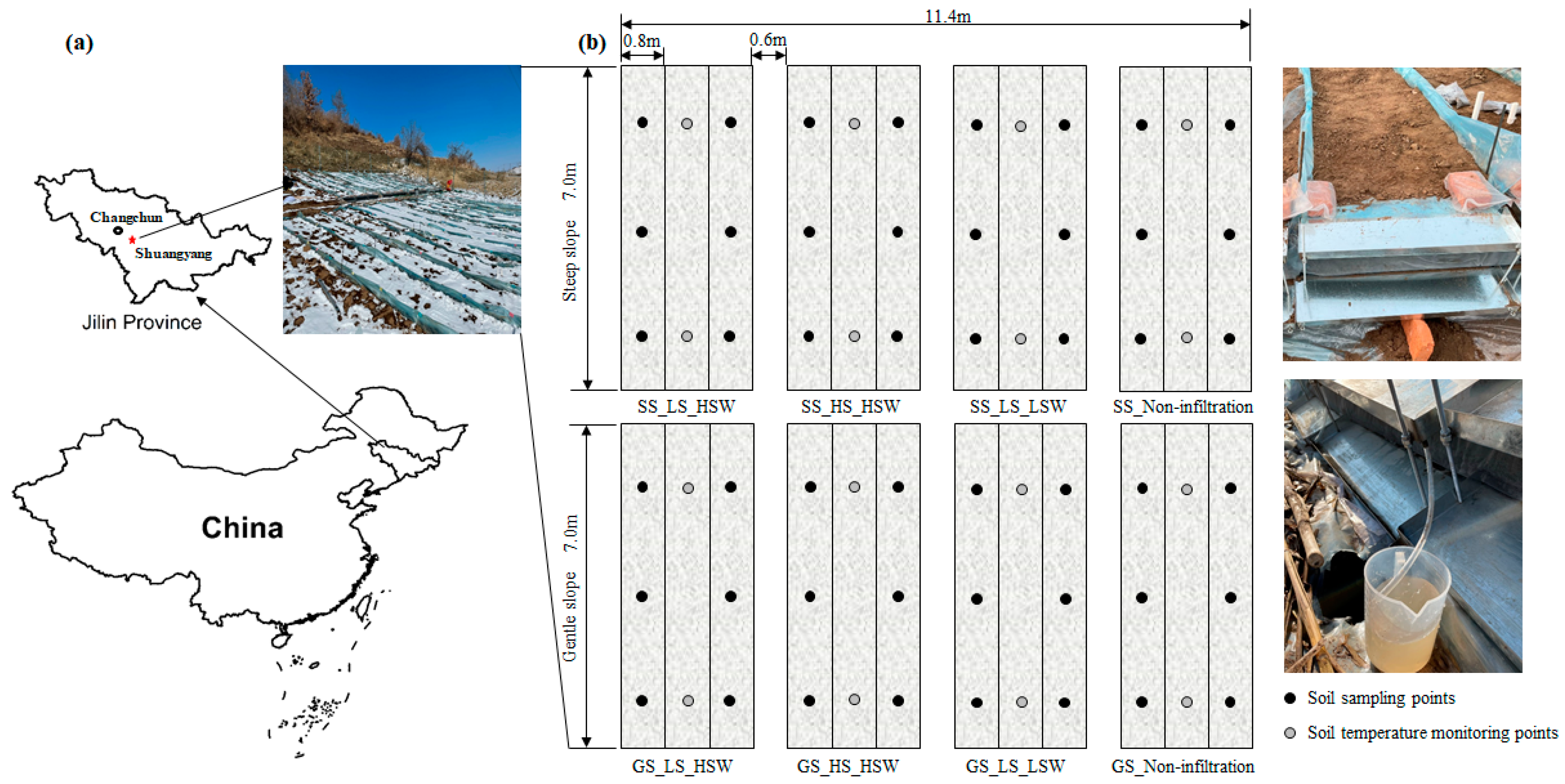
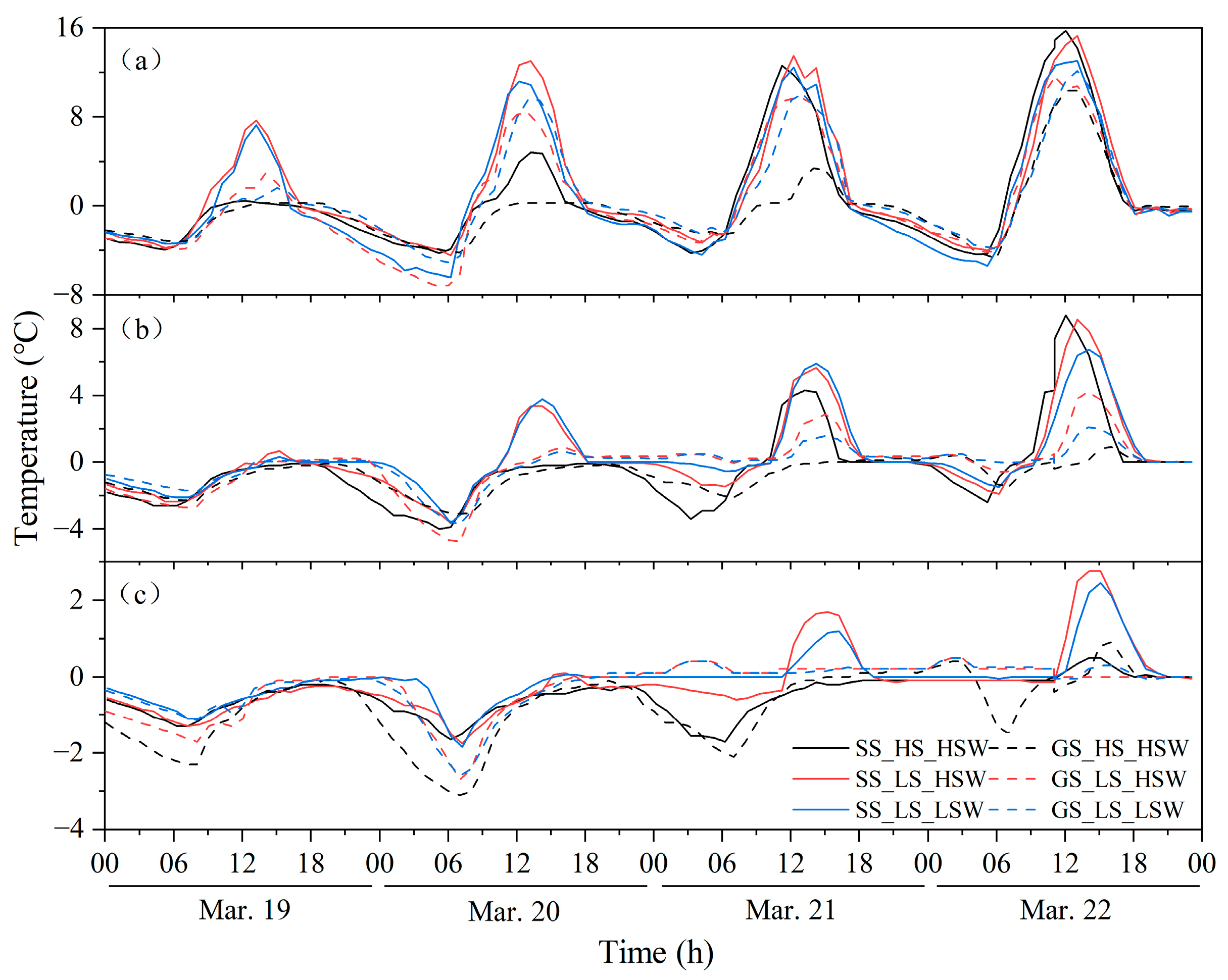


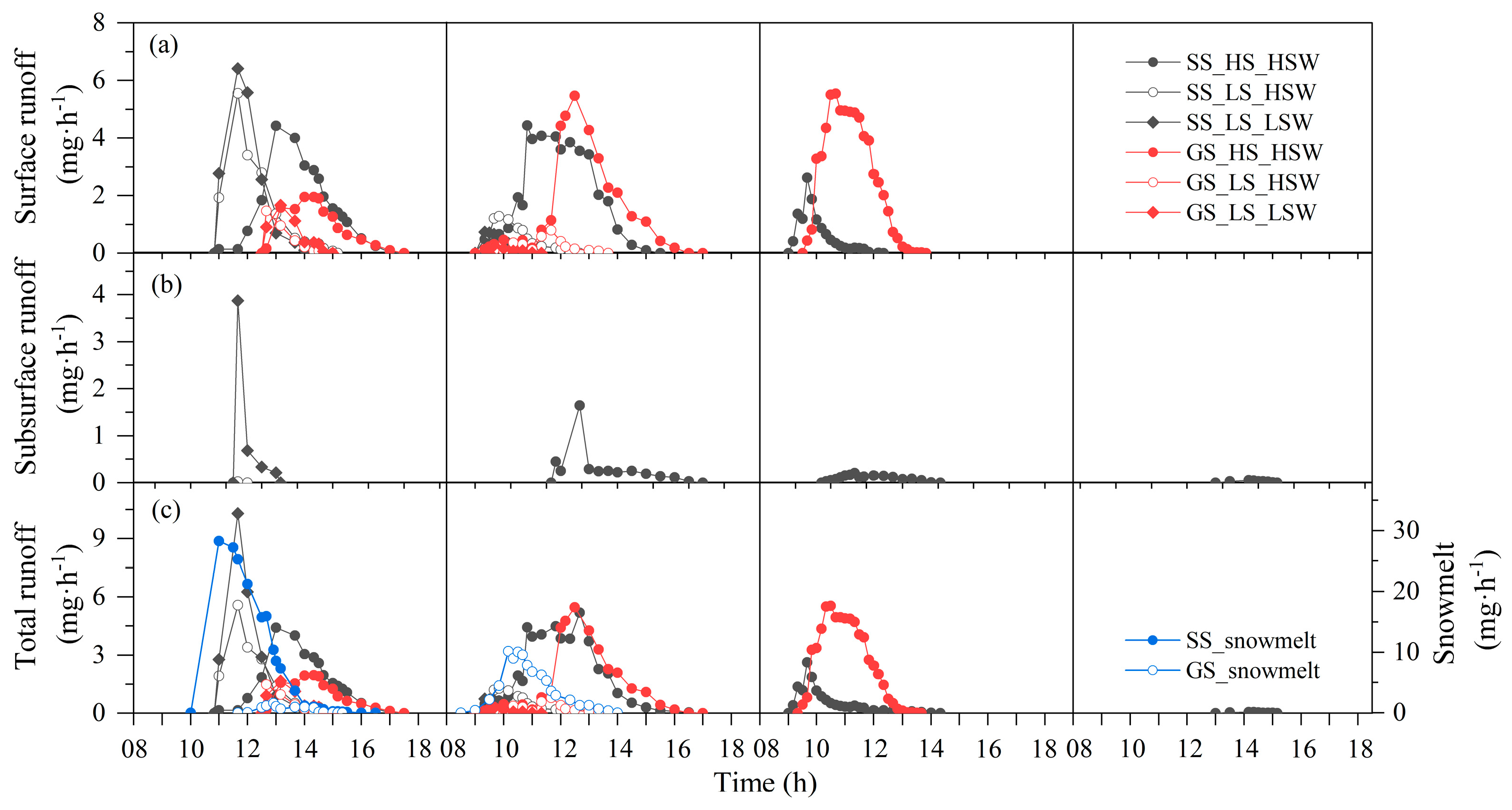

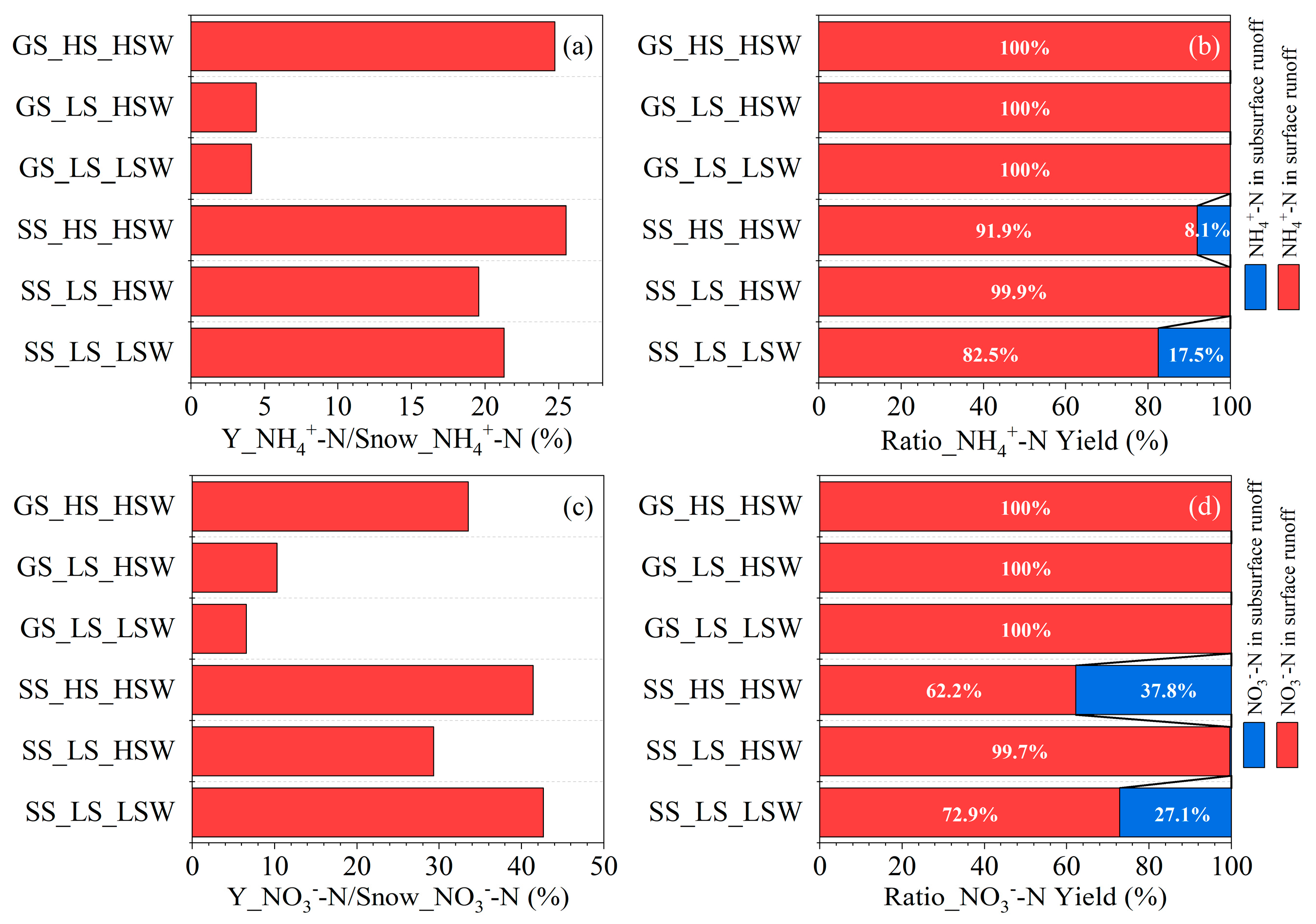
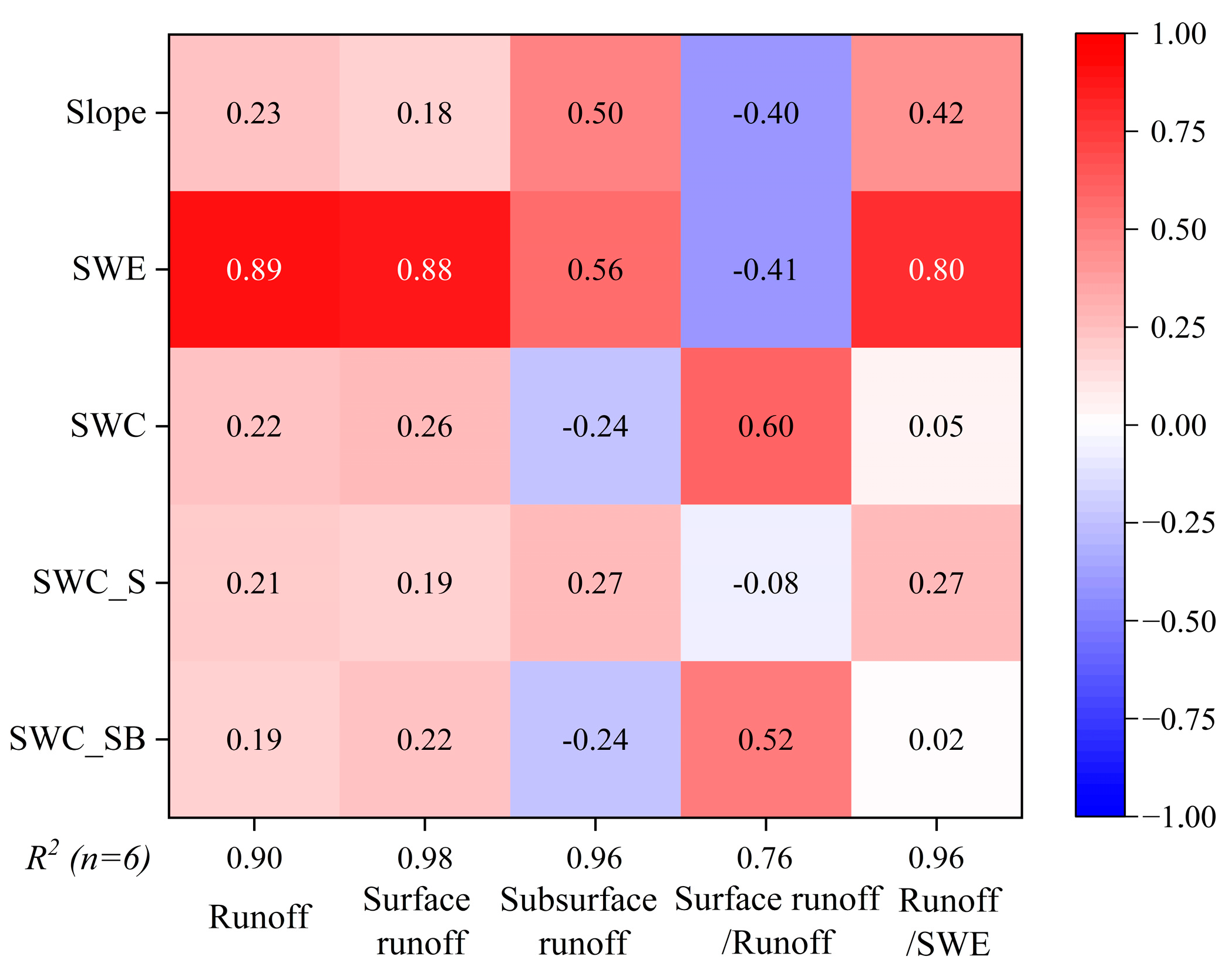
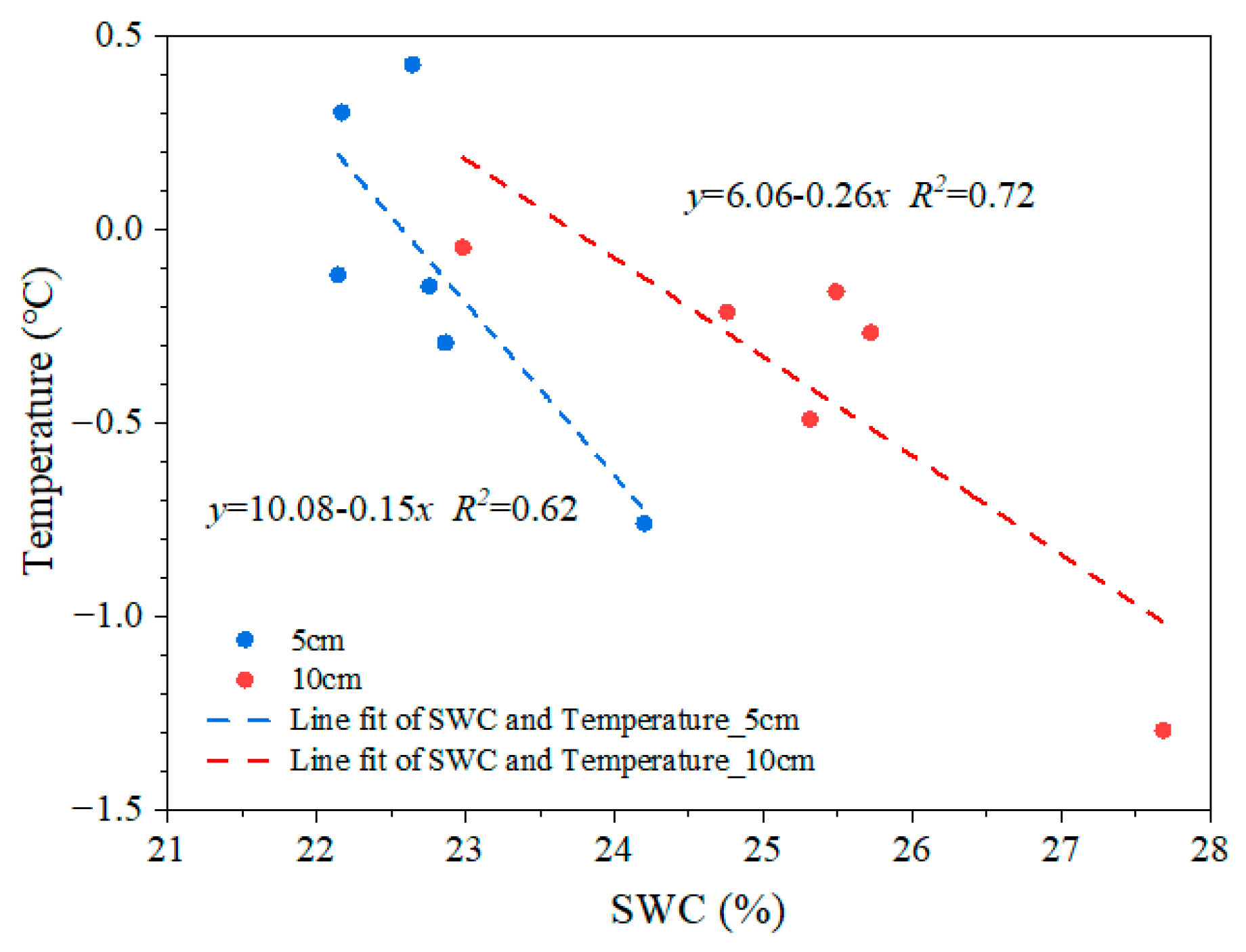
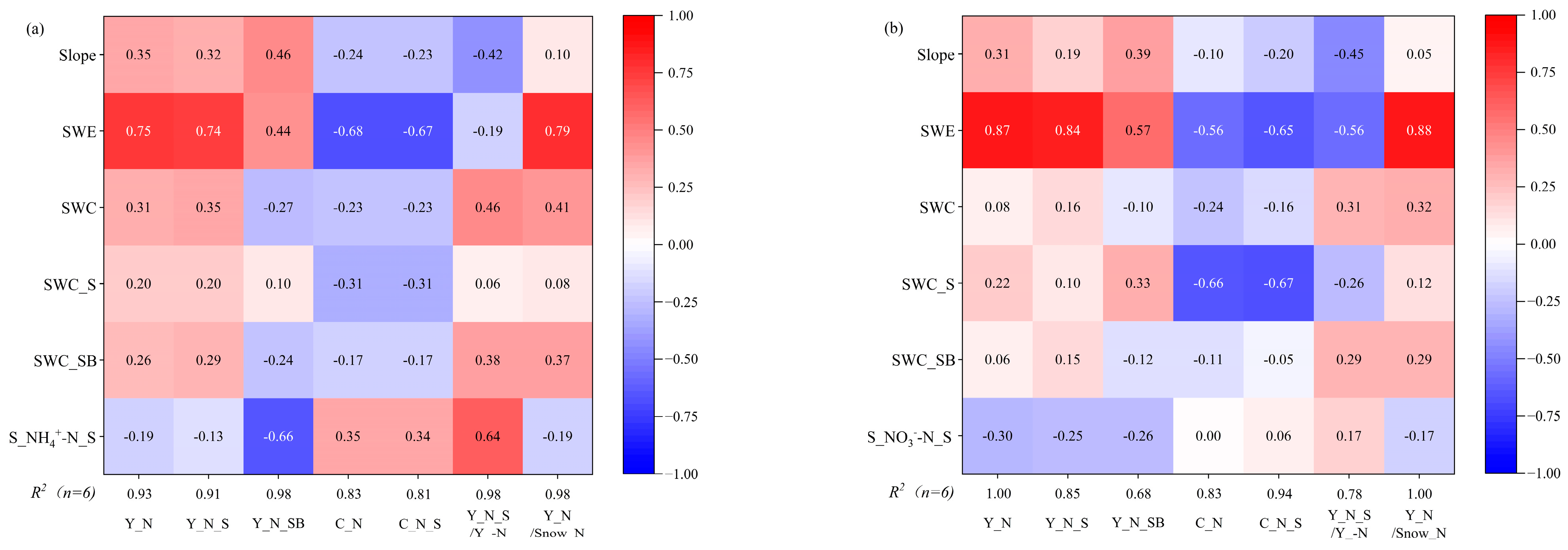
| Treatments | SWE (g) | SWC (%) | ||
|---|---|---|---|---|
| 0–20 cm | 0–5 cm | 5–20 cm | ||
| SS_HS_HSW | 66,677.3 ± 1935.8 | 24.2 ± 1.6 | 21.0 ± 2.1 | 25.3 ± 1.4 |
| SS_LS_HSW | 31,266.7 ± 501.6 | 23.3 ± 0.8 | 20.8 ± 0.8 | 24.1 ± 1.4 |
| SS_LS_LSW | 33,338.7 ± 211.2 | 21.8 ± 0.2 | 20.8 ± 1.4 | 22.2 ± 0.2 |
| GS_HS_HSW | 66,546.7 ± 708.8 | 25.1 ± 0.5 | 19.6 ± 2.0 | 27.0 ± 1.4 |
| GS_LS_HSW | 32,928.0 ± 1123.7 | 24.3 ± 2.3 | 18.8 ± 3.7 | 26.1 ± 1.8 |
| GS_LS_LSW | 31,770.7 ± 708.8 | 23.5 ± 0.2 | 20.2 ± 1.8 | 24.6 ± 0.3 |
| Parameter | Treatments | Water Yield (g) | R (%) | |||
|---|---|---|---|---|---|---|
| Mar. 19 | Mar. 20 | Mar. 21 | Mar. 22 | |||
| Snowmelt | SS_Snowmelt | 28,394.0 ± 1516.6 | 100 | 0 | 0 | 0 |
| GS_Snowmelt | 29,639.1 ± 4601 | 44 | 56 | 0 | 0 | |
| Surface runoff | SS_HS_HSW | 32,608.5 ± 2207.3 | 41 | 53 | 6 | 0 |
| SS_LS_HSW | 9929.4 ± 4164.2 | 91 | 9 | 0 | 0 | |
| SS_LS_LSW | 10,503.5 ± 3494.5 | 97 | 3 | 0 | 0 | |
| GS_HS_HSW | 35,424.1 ± 12,362.9 | 11 | 38 | 51 | 0 | |
| GS_LS_HSW | 2078.6 ± 1251.8 | 58 | 42 | 0 | 0 | |
| GS_LS_LSW | 2055.8 ± 1484.8 | 97 | 3 | 0 | 0 | |
| Subsurface runoff | SS_HS_HSW | 3496.3 ± 2877.5 | 0 | 55 | 40 | 6 |
| SS_LS_HSW | 19.4 ± 27.5 | 100 | 0 | 0 | 0 | |
| SS_LS_LSW | 2243.1 ± 2023.5 | 100 | 0 | 0 | 0 | |
| GS_HS_HSW | 0.0 | - | - | - | - | |
| GS_LS_HSW | 0.0 | - | - | - | - | |
| GS_LS_LSW | 0.0 | - | - | - | - | |
| Total runoff | SS_HS_HSW | 36,104.9 ± 4776.4 | 37 | 53 | 9 | 1 |
| SS_LS_HSW | 9948.8 ± 4175.9 | 91 | 9 | 0 | 0 | |
| SS_LS_LSW | 12,746.6 ± 4425 | 98 | 2 | 0 | 0 | |
| GS_HS_HSW | 35,424.1 ± 12,362.9 | 11 | 38 | 51 | 0 | |
| GS_LS_HSW | 2078.6 ± 1251.8 | 58 | 42 | 0 | 0 | |
| GS_LS_LSW | 2055.8 ± 1484.8 | 97 | 3 | 0 | 0 | |
| Treatments | Snow_N (mg) | S_NH4+-N (mg/L) | S_NO3−-N (mg/L) | |||||
|---|---|---|---|---|---|---|---|---|
| NH4+-N | NO3−-N | 0–20 cm | 0–5 cm | 5–20 cm | 0–20 cm | 0–5 cm | 5–20 cm | |
| SS_HS_HSW | 105.9 ± 3.1 | 176.8 ± 5.1 | 4.3 ± 0.5 | 7.6 ± 0.1 | 3.2 ± 0.7 | 4.1 ± 0.8 | 4.2 ± 0.8 | 4.1 ± 0.8 |
| SS_LS_HSW | 49.7 ± 0.8 | 82.9 ± 1.3 | 5.2 ± 0.9 | 6.9 ± 0.5 | 4.7 ± 1.0 | 3.6 ± 1.2 | 4.7 ± 2.5 | 3.3 ± 0.8 |
| SS_LS_LSW | 53.0 ± 0.3 | 88.4 ± 0.6 | 4.3 ± 1.3 | 8.1 ± 3.9 | 3.0 ± 0.4 | 7.7 ± 2.4 | 10.0 ± 2.9 | 6.9 ± 2.3 |
| GS_HS_HSW | 105.7 ± 1.1 | 176.4 ± 1.9 | 5.4 ± 0.6 | 6.7 ± 0.8 | 5.0 ± 0.5 | 7.7 ± 1.9 | 8.6 ± 1.9 | 7.4 ± 1.9 |
| GS_LS_HSW | 52.3 ± 1.8 | 87.2 ± 3.0 | 5.3 ± 0.2 | 5.8 ± 0.5 | 5.1 ± 0.4 | 8.2 ± 0.5 | 8.9 ± 0.7 | 8.0 ± 0.9 |
| GS_LS_LSW | 50.5 ± 1.1 | 84.2 ± 1.9 | 4.2 ± 0.0 | 5.0 ± 1.2 | 3.9 ± 0.4 | 9.6 ± 1.9 | 14.0 ± 1.7 | 8.1 ± 3.1 |
| Date | Slope | Water Yield (%) | NH4+-N (%) | NO3−-N (%) | ||
|---|---|---|---|---|---|---|
| Snowmelt Water | Surface Runoff | Snowmelt Water | Surface Runoff | |||
| Mar. 19 | Gentle | 10 | 13.4 | 11.1 | 13.7 | 11.4 |
| 30 | 38.8 | 31.4 | 39.5 | 31.8 | ||
| Steep | 10 | 14.6 | 13.1 | 14.2 | 12.2 | |
| 30 | 42.1 | 34.7 | 40.7 | 30.4 | ||
| Mar. 20 | Gentle | 10 | 19.4 | 14.4 | 19.3 | 14.3 |
| 30 | 47.2 | 37.3 | 46.2 | 37.0 | ||
| Steep | 10 | - | 16.8 | - | 13.7 | |
| 30 | - | 41.6 | - | 34.8 | ||
| Mar. 21 | Gentle | 10 | - | 10.2 | - | 12.7 |
| 30 | - | 30.3 | - | 33.8 | ||
| Steep | 10 | - | 24.0 | - | 16.5 | |
| 30 | - | 51.6 | - | 40.7 | ||
| Soil Depth (cm) | Changes of Soil Water Content (%) | |||||
|---|---|---|---|---|---|---|
| SS_HS_HSW | SS_LS_HSW | SS_LS_LSW | GS_HS_HSW | GS_LS_HSW | GS_LS_LSW | |
| 0–5 | −0.3 ± 1.9 | −2.7 ± 1.2 | −2.8 ± 1.0 | 2.0 ± 1.0 | 1.3 ± 2.5 | 0.7 ± 2.5 |
| 5–10 | −3.5 ± 0.3 | −3.6 ± 1.5 | −5.0 ± 0.7 | −6.0 ± 1.8 | −5.5 ± 0.8 | −2.2 ± 0.5 |
| 10–15 | −4.6 ± 2.1 | −6.0 ± 2.4 | −1.4 ± 0.8 | −0.5 ± 0.5 | −3.0 ± 0.1 | −2.2 ± 2.9 |
| 15–20 | −0.5 ± 3.0 | 0.6 ± 0.1 | 1.5 ± 1.4 | −2.1 ± 3.7 | −6.2 ± 4.5 | 0.2 ± 0.6 |
Disclaimer/Publisher’s Note: The statements, opinions and data contained in all publications are solely those of the individual author(s) and contributor(s) and not of MDPI and/or the editor(s). MDPI and/or the editor(s) disclaim responsibility for any injury to people or property resulting from any ideas, methods, instructions or products referred to in the content. |
© 2023 by the authors. Licensee MDPI, Basel, Switzerland. This article is an open access article distributed under the terms and conditions of the Creative Commons Attribution (CC BY) license (https://creativecommons.org/licenses/by/4.0/).
Share and Cite
Zhao, Q.; Zhang, J.; Wu, J.; Guo, C.; Li, C.; Liu, Y.; Zhang, R.; Zhao, H. Critical Factors Affecting Water and Nitrogen Losses from Sloping Farmland during the Snowmelt Process. Agronomy 2023, 13, 350. https://doi.org/10.3390/agronomy13020350
Zhao Q, Zhang J, Wu J, Guo C, Li C, Liu Y, Zhang R, Zhao H. Critical Factors Affecting Water and Nitrogen Losses from Sloping Farmland during the Snowmelt Process. Agronomy. 2023; 13(2):350. https://doi.org/10.3390/agronomy13020350
Chicago/Turabian StyleZhao, Qiang, Jifeng Zhang, Jingwei Wu, Chenyao Guo, Chengeng Li, Yawen Liu, Rui Zhang, and Hang Zhao. 2023. "Critical Factors Affecting Water and Nitrogen Losses from Sloping Farmland during the Snowmelt Process" Agronomy 13, no. 2: 350. https://doi.org/10.3390/agronomy13020350
APA StyleZhao, Q., Zhang, J., Wu, J., Guo, C., Li, C., Liu, Y., Zhang, R., & Zhao, H. (2023). Critical Factors Affecting Water and Nitrogen Losses from Sloping Farmland during the Snowmelt Process. Agronomy, 13(2), 350. https://doi.org/10.3390/agronomy13020350










